Crime Scene Investigation: Procedures, Evidence, and Methods
VerifiedAdded on 2022/10/12
|7
|1501
|491
Report
AI Summary
This report provides a comprehensive overview of crime scene investigation, detailing the procedures involved in evaluating and securing a crime scene. It emphasizes the importance of isolating the area to facilitate a thorough search and potential identification of perpetrators. The report outlines standard procedures, including the preservation and collection of physical evidence such as fingerprints, weapons, and blood spatter, highlighting the significance of proper storage and preservation techniques. It also discusses the methods for recording a crime scene, such as photography, note-taking, and film photography, emphasizing the need for clear and descriptive recordings. Furthermore, the report covers procedures for securing and searching a crime scene, including securing the area, surveying the scene, assigning tasks, searching for evidence, and conducting a final survey. The report concludes by summarizing the key aspects of crime scene investigation, underscoring the need for adequate knowledge of standard procedures and the importance of preserving and storing evidence for future use. The report references Frade (2017) to support the information provided.

Running Head: CRIME SCENE 0
CRIME SCENE
CRIME SCENE
Paraphrase This Document
Need a fresh take? Get an instant paraphrase of this document with our AI Paraphraser

CRIME SCENE 1
Crime scene
A crime scene is a specific place in which a certain harmful dangerous activity
occurred. Crime scene investigators usually need to have adequate knowledge in handling
crime scenes to facilitate the safety of people living within and visiting such an area.
Evaluation of a crime scene begins with total seclusion of the area to allow for a smooth
search and hence possible identification of crime culprits. There are standard procedures for
handling any given crime scene. Evidence collected from a crime scene is important and
require adequate preservation and storage. Likewise, the methods for recording a crime scene
usually include photography, taking notes, and film photography.
Procedures Associated with Crime Scene Evaluation
The process of evaluating a crime scene entails all activities that aim at identifying the
actual perpetrators of crimes (Frade, 2017). The evaluation of a crime scene attracts various
strategies and procedures across law enforcement agencies. Investigators usually have to draft
the most effective procedures across to undertake the evaluations of any given scene of a
crime. The first step in the procedure is securing the place of the crime (Frade, 2017). In
particular, this entails provision of barricades to prevent unauthorized individuals from
accessing the area. The next important step is to draw boundaries around the scene of the
crime as well as around all substantive evidence of a crime at the particular place. The third
procedure is to identify the possible route of the suspect and create a walk through from the
same. This is another important stage because it provides a guideline of the possible activities
carried out by the suspects at the actual place of a crime. The last procedure will be to record
the findings using flowcharts, sketches, and photographs.
Crime scene
A crime scene is a specific place in which a certain harmful dangerous activity
occurred. Crime scene investigators usually need to have adequate knowledge in handling
crime scenes to facilitate the safety of people living within and visiting such an area.
Evaluation of a crime scene begins with total seclusion of the area to allow for a smooth
search and hence possible identification of crime culprits. There are standard procedures for
handling any given crime scene. Evidence collected from a crime scene is important and
require adequate preservation and storage. Likewise, the methods for recording a crime scene
usually include photography, taking notes, and film photography.
Procedures Associated with Crime Scene Evaluation
The process of evaluating a crime scene entails all activities that aim at identifying the
actual perpetrators of crimes (Frade, 2017). The evaluation of a crime scene attracts various
strategies and procedures across law enforcement agencies. Investigators usually have to draft
the most effective procedures across to undertake the evaluations of any given scene of a
crime. The first step in the procedure is securing the place of the crime (Frade, 2017). In
particular, this entails provision of barricades to prevent unauthorized individuals from
accessing the area. The next important step is to draw boundaries around the scene of the
crime as well as around all substantive evidence of a crime at the particular place. The third
procedure is to identify the possible route of the suspect and create a walk through from the
same. This is another important stage because it provides a guideline of the possible activities
carried out by the suspects at the actual place of a crime. The last procedure will be to record
the findings using flowcharts, sketches, and photographs.
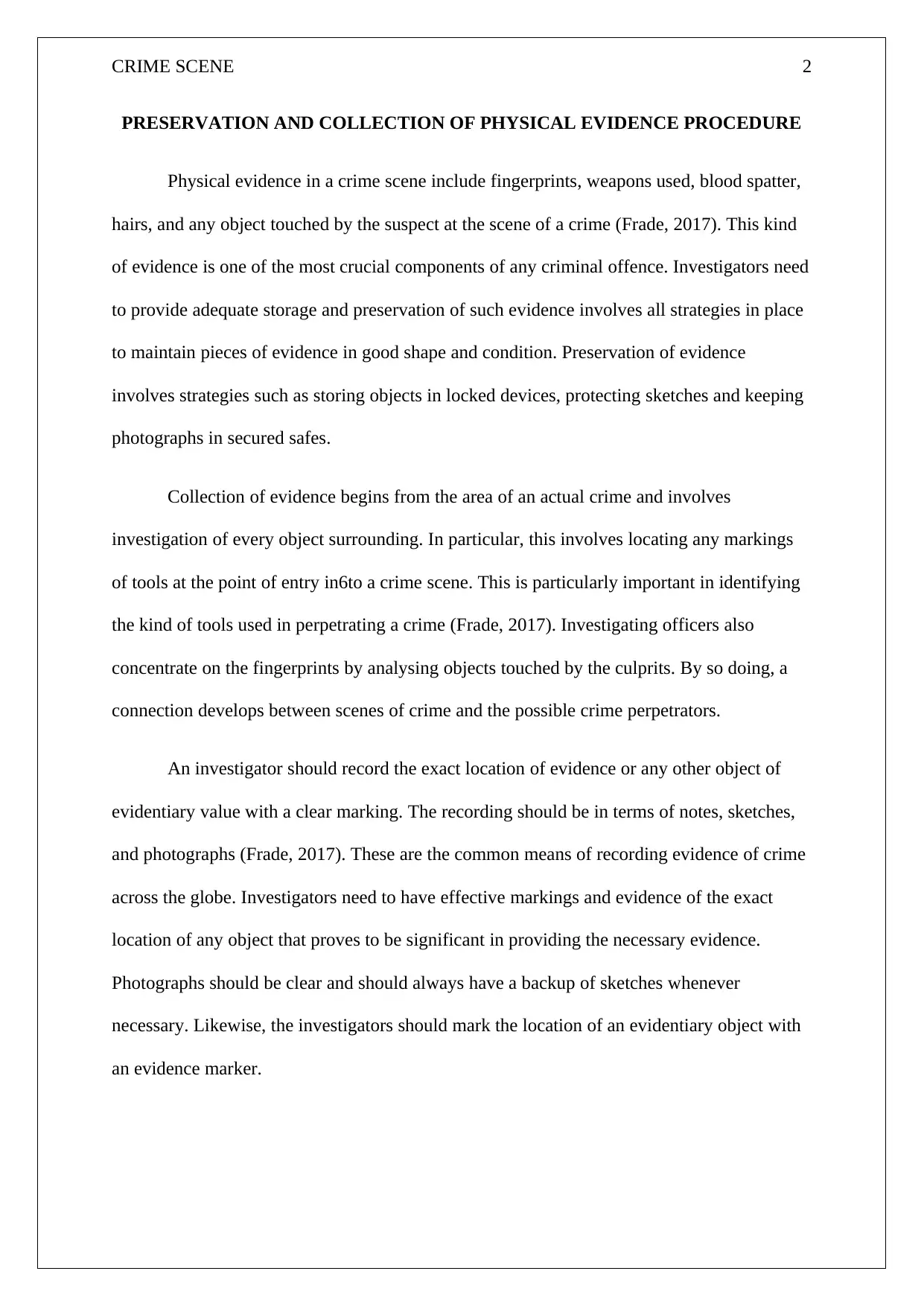
CRIME SCENE 2
PRESERVATION AND COLLECTION OF PHYSICAL EVIDENCE PROCEDURE
Physical evidence in a crime scene include fingerprints, weapons used, blood spatter,
hairs, and any object touched by the suspect at the scene of a crime (Frade, 2017). This kind
of evidence is one of the most crucial components of any criminal offence. Investigators need
to provide adequate storage and preservation of such evidence involves all strategies in place
to maintain pieces of evidence in good shape and condition. Preservation of evidence
involves strategies such as storing objects in locked devices, protecting sketches and keeping
photographs in secured safes.
Collection of evidence begins from the area of an actual crime and involves
investigation of every object surrounding. In particular, this involves locating any markings
of tools at the point of entry in6to a crime scene. This is particularly important in identifying
the kind of tools used in perpetrating a crime (Frade, 2017). Investigating officers also
concentrate on the fingerprints by analysing objects touched by the culprits. By so doing, a
connection develops between scenes of crime and the possible crime perpetrators.
An investigator should record the exact location of evidence or any other object of
evidentiary value with a clear marking. The recording should be in terms of notes, sketches,
and photographs (Frade, 2017). These are the common means of recording evidence of crime
across the globe. Investigators need to have effective markings and evidence of the exact
location of any object that proves to be significant in providing the necessary evidence.
Photographs should be clear and should always have a backup of sketches whenever
necessary. Likewise, the investigators should mark the location of an evidentiary object with
an evidence marker.
PRESERVATION AND COLLECTION OF PHYSICAL EVIDENCE PROCEDURE
Physical evidence in a crime scene include fingerprints, weapons used, blood spatter,
hairs, and any object touched by the suspect at the scene of a crime (Frade, 2017). This kind
of evidence is one of the most crucial components of any criminal offence. Investigators need
to provide adequate storage and preservation of such evidence involves all strategies in place
to maintain pieces of evidence in good shape and condition. Preservation of evidence
involves strategies such as storing objects in locked devices, protecting sketches and keeping
photographs in secured safes.
Collection of evidence begins from the area of an actual crime and involves
investigation of every object surrounding. In particular, this involves locating any markings
of tools at the point of entry in6to a crime scene. This is particularly important in identifying
the kind of tools used in perpetrating a crime (Frade, 2017). Investigating officers also
concentrate on the fingerprints by analysing objects touched by the culprits. By so doing, a
connection develops between scenes of crime and the possible crime perpetrators.
An investigator should record the exact location of evidence or any other object of
evidentiary value with a clear marking. The recording should be in terms of notes, sketches,
and photographs (Frade, 2017). These are the common means of recording evidence of crime
across the globe. Investigators need to have effective markings and evidence of the exact
location of any object that proves to be significant in providing the necessary evidence.
Photographs should be clear and should always have a backup of sketches whenever
necessary. Likewise, the investigators should mark the location of an evidentiary object with
an evidence marker.
⊘ This is a preview!⊘
Do you want full access?
Subscribe today to unlock all pages.

Trusted by 1+ million students worldwide
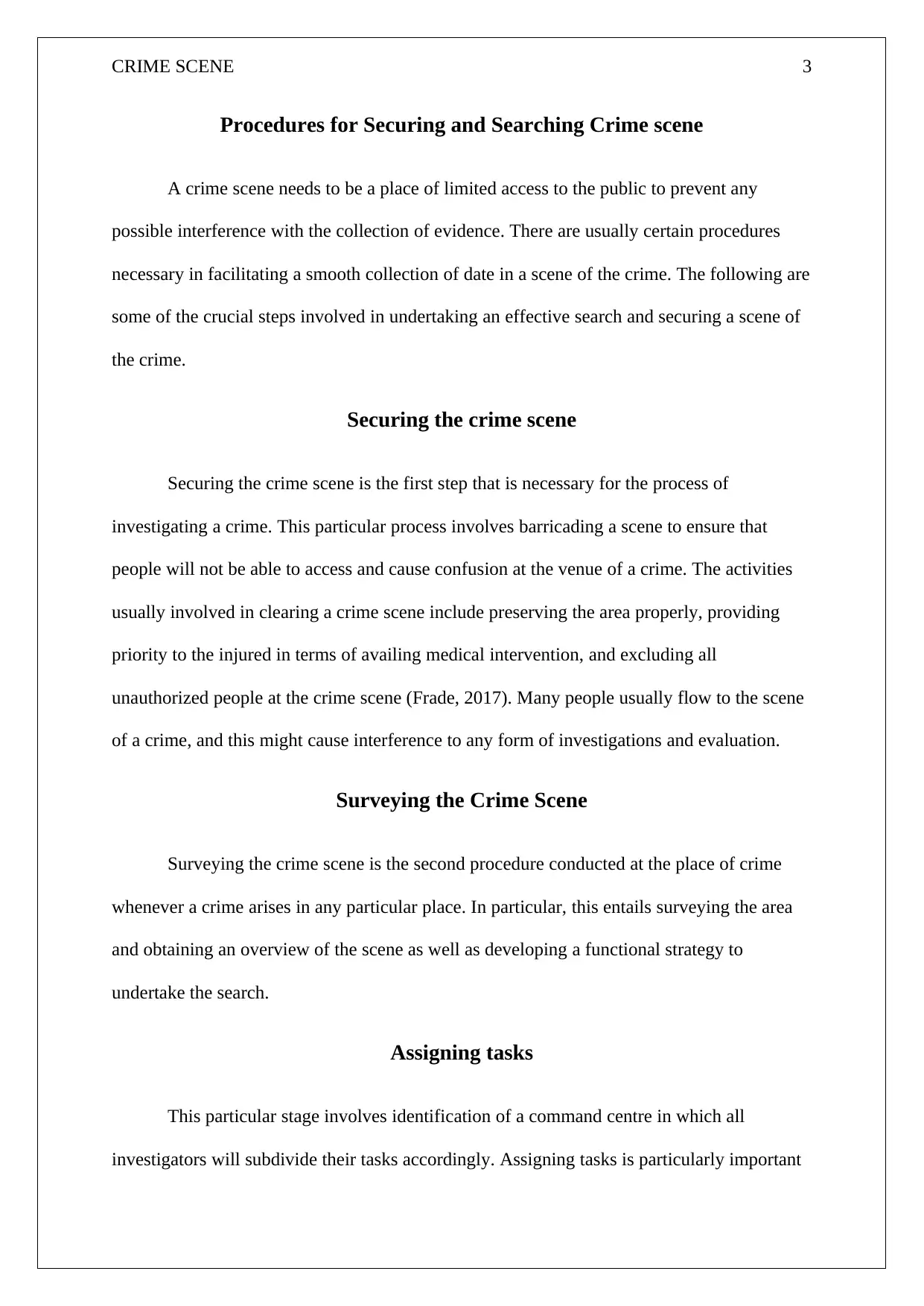
CRIME SCENE 3
Procedures for Securing and Searching Crime scene
A crime scene needs to be a place of limited access to the public to prevent any
possible interference with the collection of evidence. There are usually certain procedures
necessary in facilitating a smooth collection of date in a scene of the crime. The following are
some of the crucial steps involved in undertaking an effective search and securing a scene of
the crime.
Securing the crime scene
Securing the crime scene is the first step that is necessary for the process of
investigating a crime. This particular process involves barricading a scene to ensure that
people will not be able to access and cause confusion at the venue of a crime. The activities
usually involved in clearing a crime scene include preserving the area properly, providing
priority to the injured in terms of availing medical intervention, and excluding all
unauthorized people at the crime scene (Frade, 2017). Many people usually flow to the scene
of a crime, and this might cause interference to any form of investigations and evaluation.
Surveying the Crime Scene
Surveying the crime scene is the second procedure conducted at the place of crime
whenever a crime arises in any particular place. In particular, this entails surveying the area
and obtaining an overview of the scene as well as developing a functional strategy to
undertake the search.
Assigning tasks
This particular stage involves identification of a command centre in which all
investigators will subdivide their tasks accordingly. Assigning tasks is particularly important
Procedures for Securing and Searching Crime scene
A crime scene needs to be a place of limited access to the public to prevent any
possible interference with the collection of evidence. There are usually certain procedures
necessary in facilitating a smooth collection of date in a scene of the crime. The following are
some of the crucial steps involved in undertaking an effective search and securing a scene of
the crime.
Securing the crime scene
Securing the crime scene is the first step that is necessary for the process of
investigating a crime. This particular process involves barricading a scene to ensure that
people will not be able to access and cause confusion at the venue of a crime. The activities
usually involved in clearing a crime scene include preserving the area properly, providing
priority to the injured in terms of availing medical intervention, and excluding all
unauthorized people at the crime scene (Frade, 2017). Many people usually flow to the scene
of a crime, and this might cause interference to any form of investigations and evaluation.
Surveying the Crime Scene
Surveying the crime scene is the second procedure conducted at the place of crime
whenever a crime arises in any particular place. In particular, this entails surveying the area
and obtaining an overview of the scene as well as developing a functional strategy to
undertake the search.
Assigning tasks
This particular stage involves identification of a command centre in which all
investigators will subdivide their tasks accordingly. Assigning tasks is particularly important
Paraphrase This Document
Need a fresh take? Get an instant paraphrase of this document with our AI Paraphraser
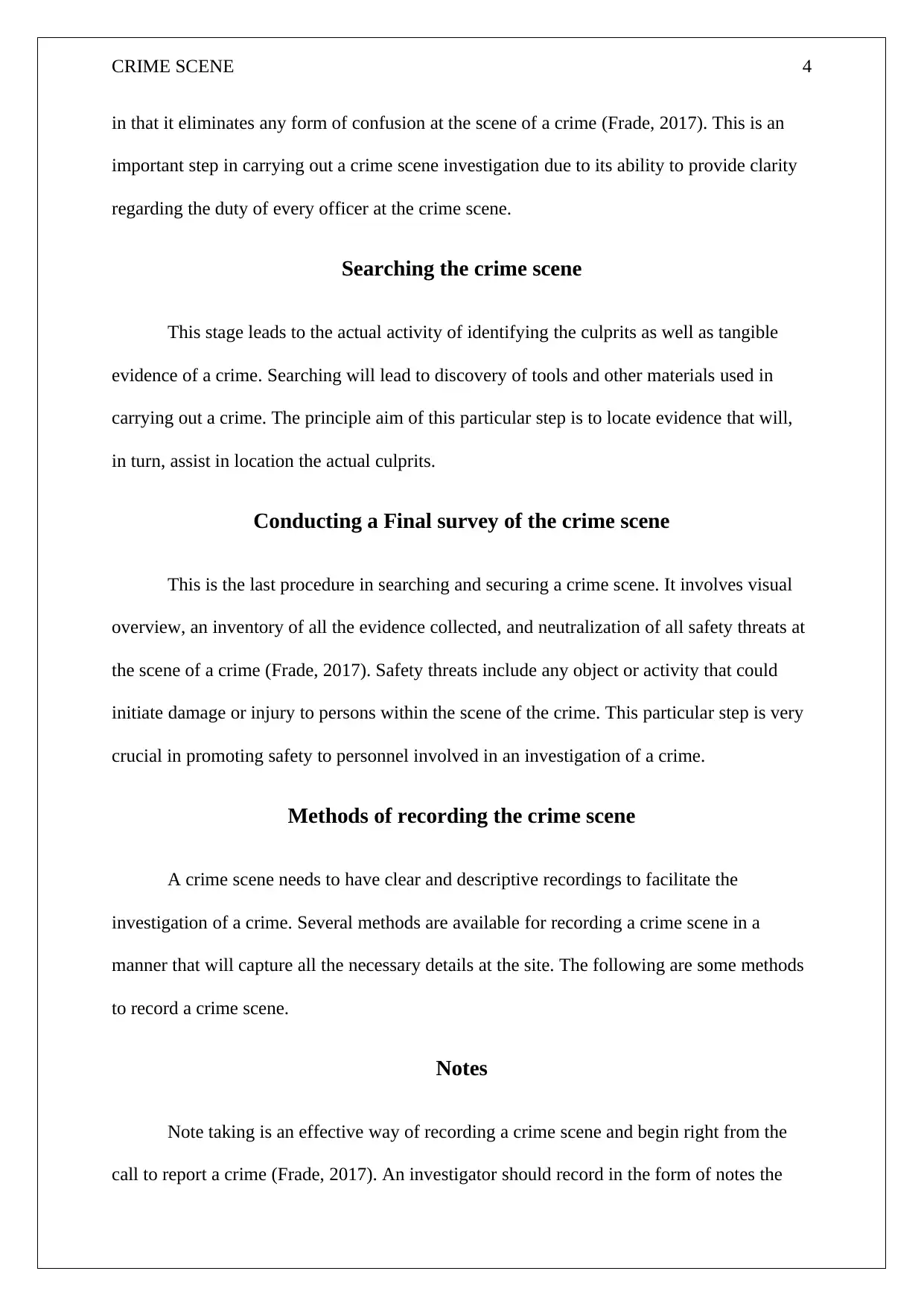
CRIME SCENE 4
in that it eliminates any form of confusion at the scene of a crime (Frade, 2017). This is an
important step in carrying out a crime scene investigation due to its ability to provide clarity
regarding the duty of every officer at the crime scene.
Searching the crime scene
This stage leads to the actual activity of identifying the culprits as well as tangible
evidence of a crime. Searching will lead to discovery of tools and other materials used in
carrying out a crime. The principle aim of this particular step is to locate evidence that will,
in turn, assist in location the actual culprits.
Conducting a Final survey of the crime scene
This is the last procedure in searching and securing a crime scene. It involves visual
overview, an inventory of all the evidence collected, and neutralization of all safety threats at
the scene of a crime (Frade, 2017). Safety threats include any object or activity that could
initiate damage or injury to persons within the scene of the crime. This particular step is very
crucial in promoting safety to personnel involved in an investigation of a crime.
Methods of recording the crime scene
A crime scene needs to have clear and descriptive recordings to facilitate the
investigation of a crime. Several methods are available for recording a crime scene in a
manner that will capture all the necessary details at the site. The following are some methods
to record a crime scene.
Notes
Note taking is an effective way of recording a crime scene and begin right from the
call to report a crime (Frade, 2017). An investigator should record in the form of notes the
in that it eliminates any form of confusion at the scene of a crime (Frade, 2017). This is an
important step in carrying out a crime scene investigation due to its ability to provide clarity
regarding the duty of every officer at the crime scene.
Searching the crime scene
This stage leads to the actual activity of identifying the culprits as well as tangible
evidence of a crime. Searching will lead to discovery of tools and other materials used in
carrying out a crime. The principle aim of this particular step is to locate evidence that will,
in turn, assist in location the actual culprits.
Conducting a Final survey of the crime scene
This is the last procedure in searching and securing a crime scene. It involves visual
overview, an inventory of all the evidence collected, and neutralization of all safety threats at
the scene of a crime (Frade, 2017). Safety threats include any object or activity that could
initiate damage or injury to persons within the scene of the crime. This particular step is very
crucial in promoting safety to personnel involved in an investigation of a crime.
Methods of recording the crime scene
A crime scene needs to have clear and descriptive recordings to facilitate the
investigation of a crime. Several methods are available for recording a crime scene in a
manner that will capture all the necessary details at the site. The following are some methods
to record a crime scene.
Notes
Note taking is an effective way of recording a crime scene and begin right from the
call to report a crime (Frade, 2017). An investigator should record in the form of notes the
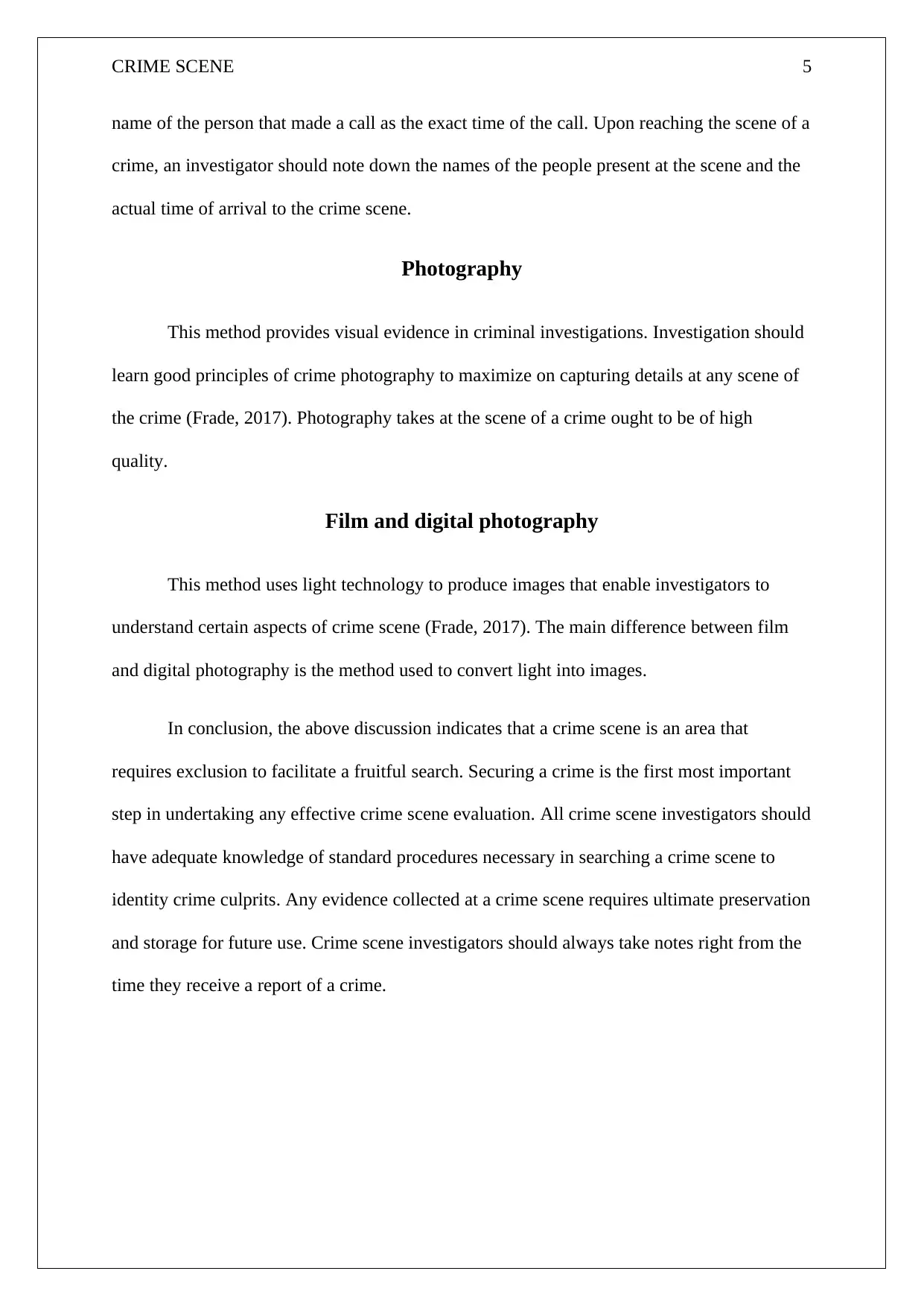
CRIME SCENE 5
name of the person that made a call as the exact time of the call. Upon reaching the scene of a
crime, an investigator should note down the names of the people present at the scene and the
actual time of arrival to the crime scene.
Photography
This method provides visual evidence in criminal investigations. Investigation should
learn good principles of crime photography to maximize on capturing details at any scene of
the crime (Frade, 2017). Photography takes at the scene of a crime ought to be of high
quality.
Film and digital photography
This method uses light technology to produce images that enable investigators to
understand certain aspects of crime scene (Frade, 2017). The main difference between film
and digital photography is the method used to convert light into images.
In conclusion, the above discussion indicates that a crime scene is an area that
requires exclusion to facilitate a fruitful search. Securing a crime is the first most important
step in undertaking any effective crime scene evaluation. All crime scene investigators should
have adequate knowledge of standard procedures necessary in searching a crime scene to
identity crime culprits. Any evidence collected at a crime scene requires ultimate preservation
and storage for future use. Crime scene investigators should always take notes right from the
time they receive a report of a crime.
name of the person that made a call as the exact time of the call. Upon reaching the scene of a
crime, an investigator should note down the names of the people present at the scene and the
actual time of arrival to the crime scene.
Photography
This method provides visual evidence in criminal investigations. Investigation should
learn good principles of crime photography to maximize on capturing details at any scene of
the crime (Frade, 2017). Photography takes at the scene of a crime ought to be of high
quality.
Film and digital photography
This method uses light technology to produce images that enable investigators to
understand certain aspects of crime scene (Frade, 2017). The main difference between film
and digital photography is the method used to convert light into images.
In conclusion, the above discussion indicates that a crime scene is an area that
requires exclusion to facilitate a fruitful search. Securing a crime is the first most important
step in undertaking any effective crime scene evaluation. All crime scene investigators should
have adequate knowledge of standard procedures necessary in searching a crime scene to
identity crime culprits. Any evidence collected at a crime scene requires ultimate preservation
and storage for future use. Crime scene investigators should always take notes right from the
time they receive a report of a crime.
⊘ This is a preview!⊘
Do you want full access?
Subscribe today to unlock all pages.

Trusted by 1+ million students worldwide
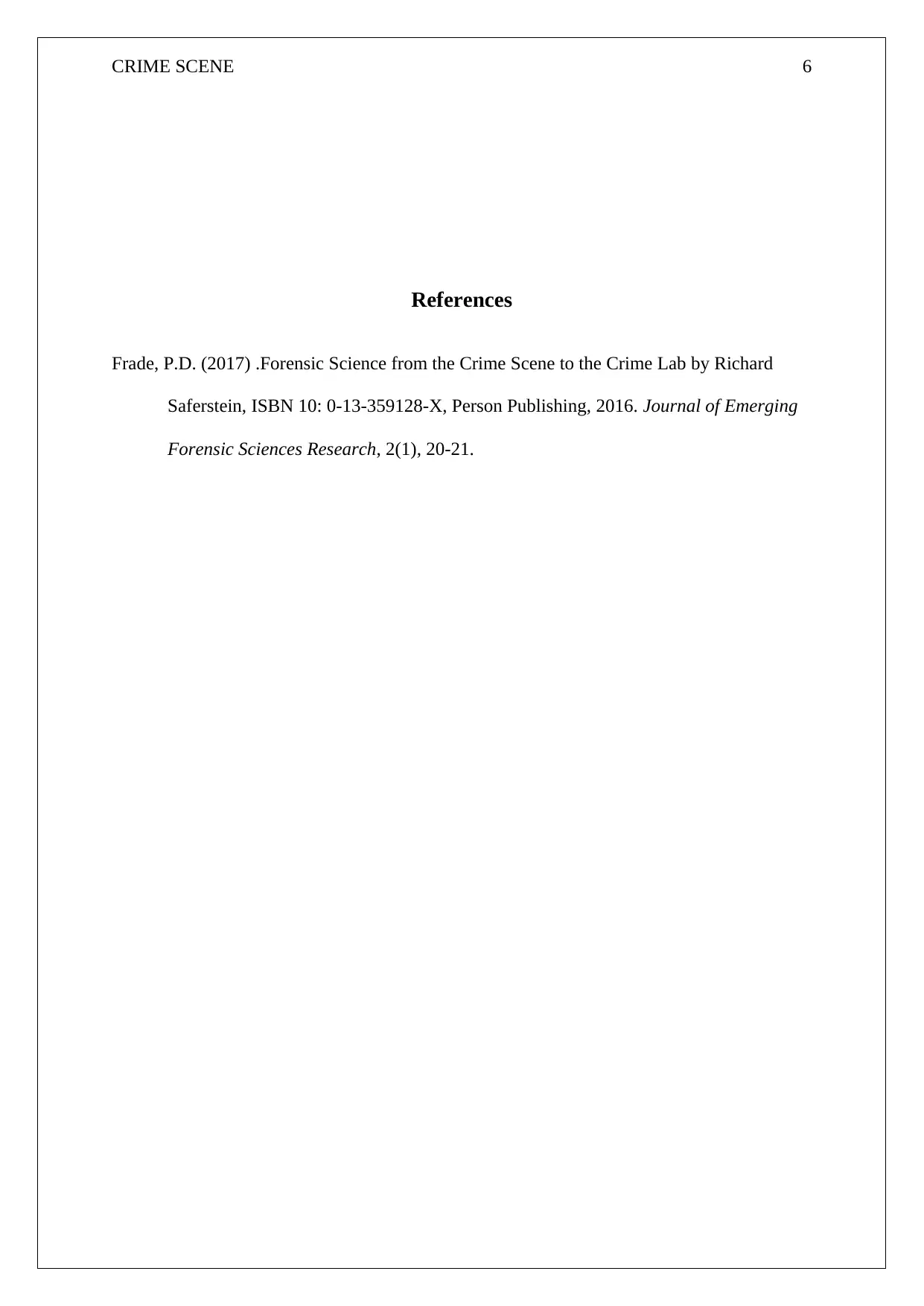
CRIME SCENE 6
References
Frade, P.D. (2017) .Forensic Science from the Crime Scene to the Crime Lab by Richard
Saferstein, ISBN 10: 0-13-359128-X, Person Publishing, 2016. Journal of Emerging
Forensic Sciences Research, 2(1), 20-21.
References
Frade, P.D. (2017) .Forensic Science from the Crime Scene to the Crime Lab by Richard
Saferstein, ISBN 10: 0-13-359128-X, Person Publishing, 2016. Journal of Emerging
Forensic Sciences Research, 2(1), 20-21.
1 out of 7
Your All-in-One AI-Powered Toolkit for Academic Success.
+13062052269
info@desklib.com
Available 24*7 on WhatsApp / Email
![[object Object]](/_next/static/media/star-bottom.7253800d.svg)
Unlock your academic potential
Copyright © 2020–2025 A2Z Services. All Rights Reserved. Developed and managed by ZUCOL.
